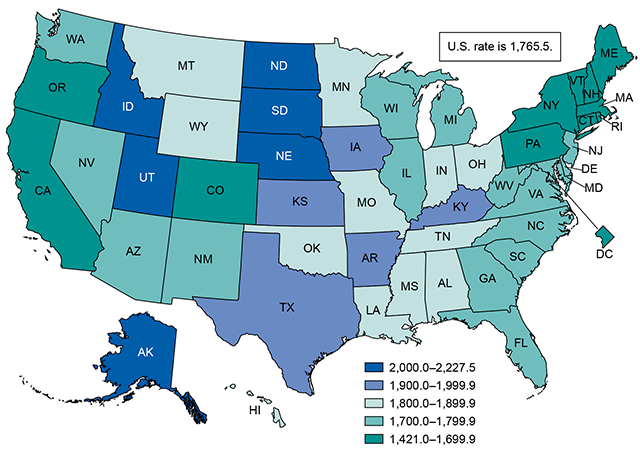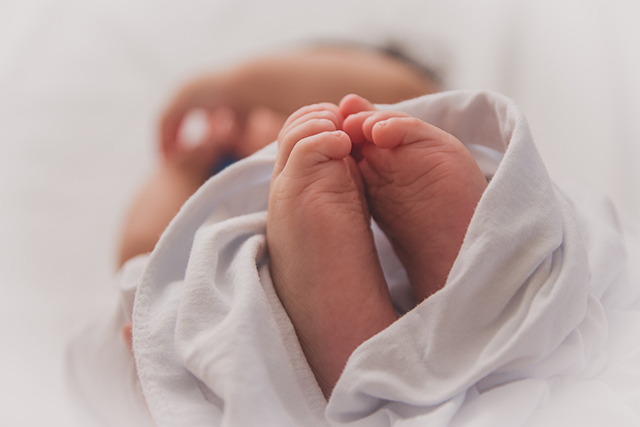American women are having fewer and fewer babies, according to a report released Thursday by the Centers for Disease Control and Prevention (CDC).
The national total fertility rate — an estimate of how many babies the average woman in the U.S. will have — was 1.765 (1,765 births per 1,000 women) in 2017, the report says. That’s a drop from 1.820 in 2016, and continues a 10-year downward trend. It’s also the lowest rate since 1978.
The U.S. fertility rate is now 16 percent below the rate — 2.100 — that experts say is needed for the country’s population to replace itself over time without immigration. Only two states, South Dakota and Utah, had fertility rates above that replacement level in 2017, according to the CDC report.
South Dakota had the highest fertility rate (2.227) in 2017, and the District of Columbia had the lowest (1.421) — a difference of 57 percent.
Minnesota’s fertility rate in 2017 was 1.872 — above the national rate, but below the replacement one.
Racial and ethnic trends
For the report, CDC researchers looked at 2017 birth certificate data from all 50 states and the District of Columbia. The certificates included self-reported information on the mother’s race and Hispanic origin.
In addition to the fertility-rate differences among states, the data revealed differences among racial and ethnic groups.
The overall fertility rate among non-Hispanic white women in 2017 was 1.666. The rate for this group did not rise above the replacement level in any of the states, although it almost reached that level in Utah (2.099). The lowest fertility rate among non-Hispanic white women was in the District of Columbia (1.012).

[image_credit]NCHS[/image_credit][image_caption]Total fertility rates, by state: United States, 2017[/image_caption]
In 2017, the overall fertility rate among non-Hispanic black women was 1.824. It was highest in Maine (4.003) and lowest in Wyoming (1.146).
Among Hispanic women, the overall fertility rate was 2.006. It was highest in Alabama (3.085) and lowest in Vermont (1.200).
In Minnesota, the fertility rate in 2017 was 1.727 among non-Hispanic white women, 2.900 among non-Hispanic black women and 2.168 among Hispanic women. Those rates were all higher than the national ones.
Not necessarily a negative thing
The CDC report does not speculate on why the U.S. fertility rate is declining, but other experts have pointed to several possible reasons, including greater access to contraceptives, a decline in teen pregnancy and women starting their families at later ages.
In addition, attitudes regarding the ideal family size appear to be changing. In a 2013 survey, almost half of Americans said that two is the best number of children for a family.
The CDC report also doesn’t comment on whether a shrinking population is a good or a bad thing for the country. Some economists have argued that decreasing populations lead to increasing standards of living.
FMI: The CDC report can be read in full online.






Important caveat from the discussion section of the report: “the TFRs reported here, particularly the highest or lowest rates for a given race and Hispanic-origin group, may reflect a relatively small number of births and population size for a given state.” In other words, non-Hispanic black women may not really be so dramatically more fertile in Maine than in Wyoming, and Hispanic women may not really be so dramatically more fertile in Alabama than in Vermont. Given the small amount of data, those numbers may be misleading.
“In addition, attitudes regarding the ideal family size appear to be changing. In a 2013 survey, almost half of Americans said that two is the best number of children for a family.”
Why does this stat have no context? Has the ideal size risen or fallen, by how much, and over what period of time?
While some economists may theorize about declining populations being beneficial, it doesn’t seem to be working out well for Japan.
Great news. I find it hilarious that most news services are treating this as a bad thing. We have plenty of people already. Plus the robots are coming!
The bad side is that it means that the population is aging; a larger proportion of the population has retired and must be supported by the rest of the population. This is true even when retirees are relatively wealthy — someone must provide the goods and services that they want to purchase.
That’s my immigration is a good thing — most immigrants are relatively young and reduce the overall population age.
Yes, fewer babies might be seen as a great thing by some, until there is no one there to care for their elderly parents, or themselves. If no babies are born after this year, do you think you’ll have a dentist to fix your teeth in 30 years?
The financial assets of retirees are only as good as the economy is productive. A shrinking economy means that there is less wealth. If your 401K did better from 2008 to 2010, raise your hand.